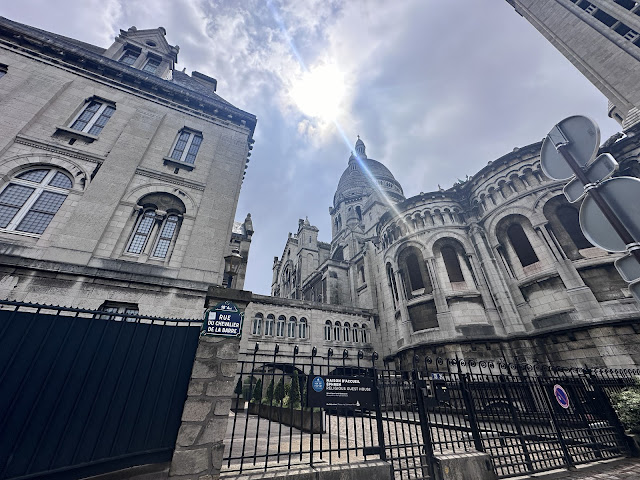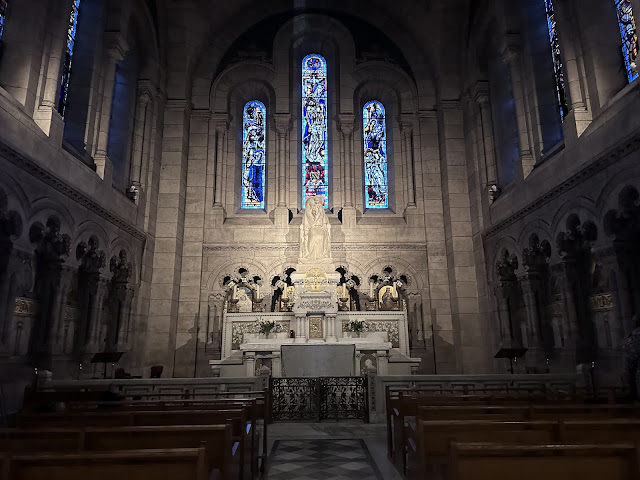Did you know that Paris’ second most visited attraction is not a palace or a museum but a place of prayer? The Basilica of the Sacred Heart of Montmartre, known as Sacré-Cœur, welcomes more than ten million visitors each year. It is the most visited sacred site in France and second only to the Eiffel Tower among all Paris landmarks.
While many come for the sweeping views and iconic white domes, few realize that you can actually spend the night there. I did. And for a Catholic traveler, it felt more like a retreat than a typical stay.
On my last night in Paris, I checked in at the guesthouse beside the basilica, formerly known as Ephrem House. Hidden just behind the crowds that flock to the front steps each day, the guesthouse offers a quiet refuge for pilgrims.
By then, I had already completed my Paris checklist. I had visited the major landmarks, walked through charming neighborhoods, and paid a special visit to the Chapel of Our Lady of the Miraculous Medal on Rue du Bac, where the Virgin Mary appeared to Saint Catherine Labouré in 1830. Before arriving in Paris, I had also spent several peaceful nights in Lourdes, the Marian sanctuary where Our Lady appeared to Saint Bernadette. Those days filled my heart with quiet joy. I thought the best way to end my journey was in prayer—simply to say thank you.
That evening, I traveled from Bercy, where I had stayed earlier in the trip. It was raining heavily and I had a large suitcase. Several Uber drivers canceled before one finally accepted. I prayed I would arrive in time for check-in. I did, though the driver struggled to find the right drop-off point. We circled the basilica twice before I asked him to stop near the main entrance. The rain was unrelenting. There was a long queue outside, and I was cold, drenched, and unsure where to go. I left my luggage at the base of the steps and asked the guard for directions. He pointed me to the back entrance.
Dragging my suitcase uphill in the rain, I finally arrived at the guesthouse, soaking wet.
I rang the bell and tried to explain myself in English. Thankfully, a woman exiting the gate let me in. I showed my passport and booking papers. I had reserved a meal along with my stay, and the receptionist gently asked me to hurry as dinner service was ending. I left my luggage in my room and rushed to the dining hall.
The staff was clearly winding down for the night, and I was thankful they still welcomed me. A group was finishing their meal and I knew I had arrived just in time. The food was warm and comforting, though milder than what I’m used to back home. Still, I was grateful for something hot after a long and rainy journey. I ate quickly and returned to my room to change into dry clothes.
My room was modest but clean, with a single bed, a cabinet, and a small desk. I also had fresh linens and towels. There was a shower and sink inside, but the toilet was shared and located outside the room. I had been concerned about needing to get up in the middle of the night, but it turned out to be manageable.
The guesthouse can host up to 170 people in single, double, and triple rooms, as well as dormitories for groups and pilgrims. It also has a chapel, dining area, meeting spaces, and gardens. Despite its capacity, the halls were quiet. Aside from the dining room and a few function rooms, I hardly saw anyone. That night, it felt like I had an entire wing to myself.
After a short rest, I prepared for Mass. This was the reason I had come. I wanted to experience the basilica at night without tourists, without cameras—just prayer.
At ten in the evening, a simple and beautiful Mass was celebrated. At eleven, Eucharistic adoration began.
What makes this place truly special is that Sacré-Cœur has been home to perpetual adoration since August 1, 1885. The Blessed Sacrament has remained exposed continuously, day and night, for more than a century. Each evening, after the basilica closes to the public, the night vigil is taken over by those staying at the guesthouse. Upon check-in, guests are invited to choose an hour of silent prayer during the night.
It was deeply humbling to be there, knowing that someone had been praying in this space every hour of every day for over one hundred years. I did not explore the basilica that night. I simply kept my hour, sat in silence, and returned to my room with a full heart.
I woke early the next morning, checked out, and left my luggage at the guesthouse’s storage area so I could return to the basilica and take it all in. I chose to skip breakfast and spend that time exploring instead.
The interior is vast. I walked around quietly, grateful for the calm and the near-empty space. The most striking feature is the mosaic above the altar, known as Christ in Majesty, the largest mosaic in France. Spanning 475 square meters, it depicts Jesus with His arms open wide, His Sacred Heart radiant, surrounded by angels and saints.
The basilica itself is 85 meters long and 35 meters wide. At the center is a large rotunda, surrounded by a nave, two transepts, and an advance-choir that form a cross-shaped plan. The chapels along the walls were donated by guilds and religious communities, each one adorned with reliefs, tapestries, or sculptures tied to the professions or spiritual devotion of its benefactors.
Starting to the right of the main entrance, chapels are dedicated to Archangel Michael, Saint Louis, Marguerite-Marie Alacoque, and Our Lady of the Sea. Around the apse are more chapels honoring Saint Francis of Assisi, Saint John the Baptist, Saint Joseph, the Virgin Mary, Saint Luke, Saint Ignatius of Loyola, Saint Ursula of Cologne, and Saint Vincent de Paul. There are also tribunes representing commerce and agriculture, and a chapel devoted to the Queens of France.
One of the most remarkable features is the grand pipe organ built by Aristide Cavaillé-Coll, the most renowned organ builder in nineteenth-century Paris. It is still used during Mass and major liturgical celebrations.
There is also a small souvenir shop inside where visitors can purchase prayer cards, medals, rosaries, and other keepsakes.
Montmartre itself is a sacred hill, traditionally believed to be the site of the martyrdom of Saint Denis, the first bishop and patron saint of Paris.
After spending time in the basilica, I stepped out onto the Parvis to take in the view. Even under gray skies, the panorama of Paris was breathtaking.
I admired the basilica’s façade, walked around Montmartre, rode the funicular, and took the train to buy a few last-minute gifts for friends back home. Before leaving, I returned once more to the basilica to gaze up at the mosaic, offer a final prayer of thanks, and of course, claim my luggage.
I had originally planned to visit the crypt and climb to the dome, but I was already overwhelmed in the best way. I decided to save those for a future trip.
If you are Catholic and planning a visit to Paris, I encourage you not just to see Sacré-Cœur. Stay. Pray. Rest. Let Christ be the last thing you see before you sleep and the first thing you greet when you wake.
To inquire or reserve, you can email hotellerie@sacrecoeurdemontmartre.fr or call between nine in the morning and six in the evening.





















0 comments